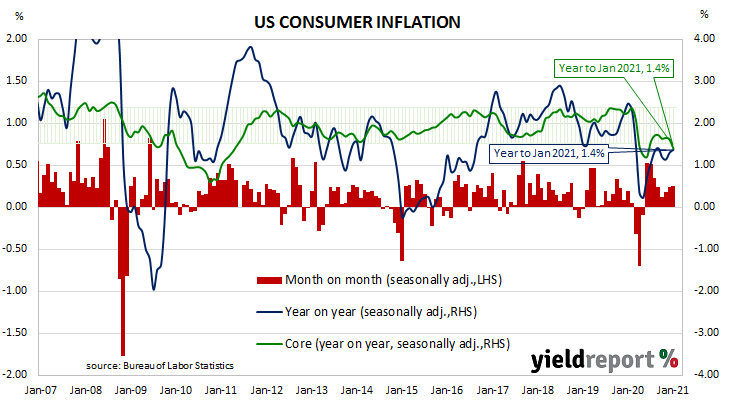Summary: January US CPI up in January; under expectations; “core” rate flat; “no signs” of inflationary pressures”; headline rate driven by higher fuel prices; used vehicles prices down again, Fed January’s UIG annual rate unchanged from December; categories with higher prices during 2020 reversing.
The annual rate of US inflation as measured by changes in the consumer price index (CPI) halved from nearly 3% in the period from July 2018 to February 2019. It then fluctuated in a range from 1.5% to 2.0% through 2019 before rising above 2.0% in the final months of that year. Substantially lower rates were reported from March to May but subsequent reports indicated consumer inflation has largely returned to pre-pandemic levels.
The latest CPI figures released by the Bureau of Labor Statistics indicated seasonally-adjusted consumer prices rose by 0.3% on average in January. The result was less than the 0.4% increase which had been generally expected but above December’s 0.2% increase after it was revised down from +0.4%. On a 12-month basis, the inflation rate ticked up from December’s reading of 1.3% to 1.4%.

“Headline” inflation is known to be volatile and so references are often made to “core” inflation for analytical purposes. Core inflation, a measure of inflation which strips out the volatile food and energy components of the index, returned a flat reading on a seasonally-adjusted basis for the month. The result was less than the expected 0.1% but the same as December’s figure. The seasonally adjusted annual rate fell back to 1.4% after slipping to 1.6% in December.
“Shelter prices, 33% of the CPI, remained soft and elsewhere in the report there were no signs of emerging inflationary pressures,” said ANZ economist John Bromhead.
Long-term US Treasury bond yields fell moderately on the day. By the close of business, US 10-year and 30-year yields had each shed 4bps to 1.12% and 1.91% respectively. The 2-year yield finished unchanged at 0.11%.
In terms of US Fed policy, expectations of any change in the federal funds range over the next 12 months remained fairly soft. February 2022 futures contracts implied an effective federal funds rate of 0.08%, in line with the spot rate.

